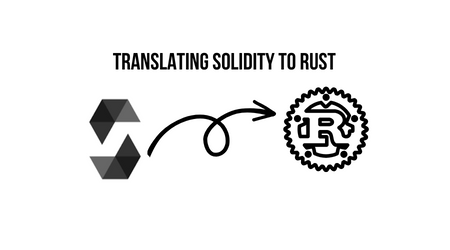From understanding the basics to handling data types, you’ll gain the proficiency needed to effortlessly bridge the gap between the two powerful languages, Solidity and Rust.
For a quick look at how the conversion works, use the following Solidity to Rust converter.
1. Key Takeaways
- Solidity and Rust are both programming languages used for blockchain development, with Solidity being specific to Ethereum and Rust offering better performance and memory safety.
- When translating Solidity syntax to Rust, it is important to understand the differences in language structure, error handling, and type annotations.
- Converting smart contracts from Solidity to Rust can offer improved memory safety, concurrency, and performance, but may also present challenges for complex contracts.
- Rust provides various data structures and variable types for efficient memory management, and Solidity arrays can be converted to Rust vectors for dynamic resizing and memory allocation.
2. Understanding the Basics of Solidity and Rust
Understanding the basics of Solidity and Rust is vital for successfully translating code. When it comes to smart contract development, Solidity and Rust have key differences.
Solidity is specifically designed for Ethereum and is a statically typed, contract-oriented programming language.
Rust, on the other hand, is a general-purpose language that offers advantages over Solidity for blockchain development, such as memory safety and concurrency.
Now, let’s delve into the process of translating Solidity syntax to Rust seamlessly.
3. Translating Solidity Syntax to Rust
When working with Solidity syntax in Rust, it’s important to familiarize yourself with the differences in language structure. While both languages are used for smart contract development, there are notable distinctions.
Here are some key points to keep in mind:
- Error handling in Rust is more robust and allows for better code reliability.
- Rust offers better performance compared to Solidity, thanks to its low-level control and optimizations.
- Rust’s syntax is stricter and requires explicit type annotations.
- Solidity has built-in support for Ethereum-specific features like events and modifiers.
- Rust’s memory management system ensures safer and more secure code execution.
Understanding these differences will help you effectively translate Solidity contracts to Rust without compromising performance or functionality.
Now, let’s dive into the process of converting smart contracts from Solidity to Rust.
4. Converting Smart Contracts From Solidity to Rust
To convert your smart contracts from Solidity to Rust, you’ll need to consider the differences in language structure and make adjustments accordingly.
There are potential challenges in converting complex smart contracts from Solidity to Rust, but there are also significant benefits to using Rust for smart contract development over Solidity.
Rust offers improved memory safety, concurrency, and performance. In order to fully understand the process, let’s explore how to handle data types and variables in Rust for solidity developers.
5. Handling Data Types and Variables in Rust for Solidity Developers
Handling data types and variables in Rust for solidity developers involves familiarizing yourself with Rust’s syntax and conventions for declaring and manipulating different types of data. Here are some key points to keep in mind:
- Rust offers various data structures like arrays, vectors, and tuples for efficient memory management.
- Solidity arrays can be easily converted to Rust vectors, which provide dynamic resizing and efficient memory allocation.
- Rust supports different variable types, including integers, floats, booleans, and strings.
- Rust allows for explicit type annotations, ensuring type safety and preventing unexpected behavior.
- Rust provides pattern matching, allowing you to handle different data types and values in a concise and expressive manner.
Understanding these concepts will help you effectively handle data types and variables in Rust when translating your Solidity code.
Now, let’s explore the best practices for translating Solidity code to Rust.
6. Best Practices for Translating Solidity Code to Rust
One of the best practices for converting Solidity code to Rust involves familiarizing yourself with the syntax and conventions of both languages. This is crucial for ensuring code security and optimizing performance.
Solidity and Rust have different approaches to handling variables, memory management, and error handling. By understanding these differences, you can effectively translate Solidity code to Rust while preserving its functionality and improving its efficiency.
Pay close attention to data types, structuring contracts, and implementing error handling mechanisms to ensure a smooth transition.

